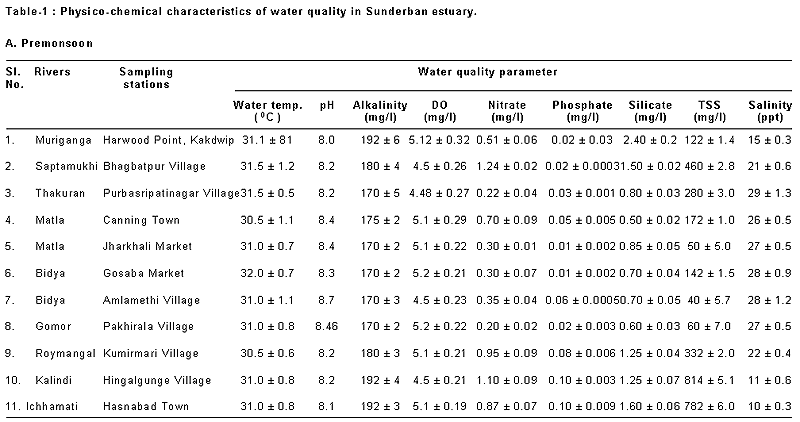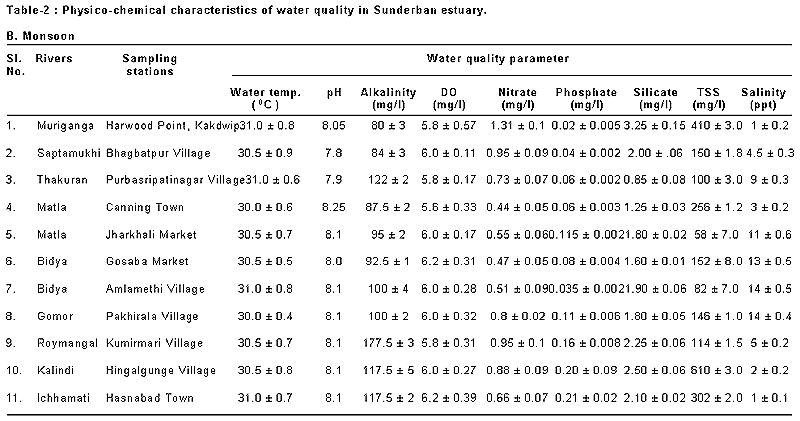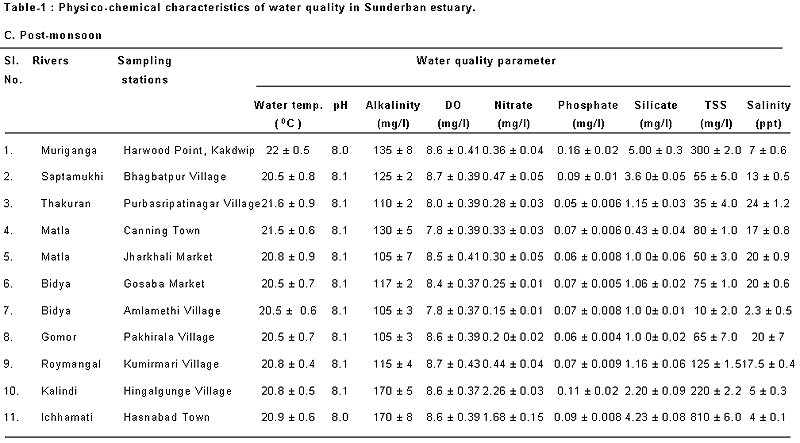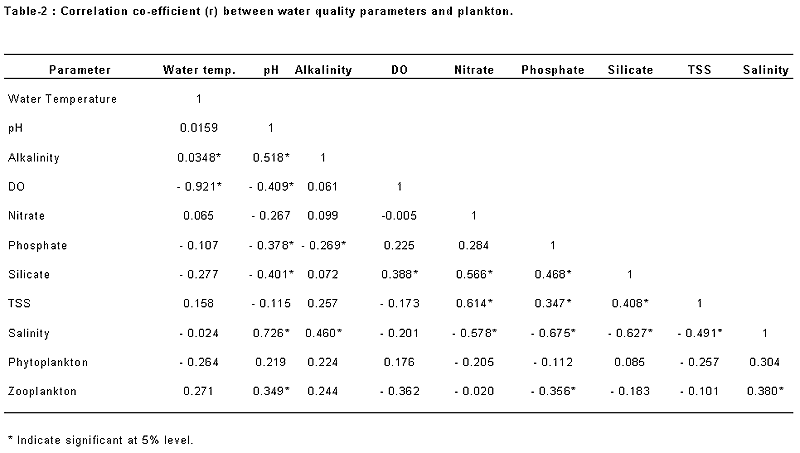

0689-B2
BAISAKHI BANDYOPADHYAY 1
Due to the complex topographical structure of Mangrove forest Sundarban area situated in the delta of Bay of Bengal in the state of west Bengal, India , this estuary showed salinity gradient from the upstream to the downstream part and also margin to central part. Seasonal and spatial distribution of plankton in the estuary were discernable.. The phytoplankton species like Coscinodiscus and Biddulphia and zooplankton species like Tintinnid protozoa and Calanoid copepoda were the most dominant forms. Most of the physico-chemical properties of water did not show any significants correlation with phytoplankton population, but salinity showed positive significant correlation with zooplankton population.
Plankton is one of the major produces of the estuary, and thus contributes substantially to the gross productivity of the area. The Sunderban estuary is formed by a complex network of upstream rivers where the spatial and seasonal variations of some hydrochemical characters are quite prominent. The present paper thus deals with the species composition and quantitative abundance of planktons of the sunderban estuary of West Bengal (India) and its relationship with physico-chemical characteristics of riverian water. The water quality parameters of rivers showed marked variation in different seasons. Among the planktons, the phytoplankton showed the highest species diversity in all stations and all seasons There was also a marked variation of phytoplankton forms in seasons and sampling locations due to variations of water quality parameters, viz, salinity, TSS and nutrients. During premonsoon the dominant phytoplankton were species of Ditylum, Ceratium, Biddulphia, Chaetoceros, Coscinodiscus, Thalassiothrix, Rhizosolenia and Thalassionema. However, during postmonsoon phytoplankton species of Bacteriastrum, Biddulphia, Protoperidinium were most dominant. But in monsoon species of Skeletonema, Fragillaria and some blue green and also euglenoids are quite common. The average phytoplankton load is higher mostly in postmonsoon period except in few stations where premonsoon load is higher. There is some variation of plankton in different sampling sites. The eastern part of the estuary is dominated by phytoplankton species like Biddulphia diatoms and green and blue green algae, while the central part is dominated by a variety of diatom species viz, Chaetoceros, Coscinodiscus, Bacterioastrum, Cyclotella, Ditylum, Skeletonema, Thallassiothrix, Thalassionema and Triceratium. In contrary, the western region is dominantly represented by species of Fragillaria, Gyrosigma, Nitzschlia and Bacillaria. With respect to distribution of zooplankton variation in different stations are less marked. The seasonal variation of phytoplankton load indicates that there is a bimodal pattern of distribution with one in premonsoon (May) and other in postmonsoon (November). Such biomodal seasonal cycle is a common event throughout the coastlines in India. The plankton species composition and abundance depend upon a variety of water quality parameters viz, temperature, pH, salinity, nutrients, dissolved oxygen and total suspended solid. Among these factors, in tropics the role of temperature is of limited significance owing to low range of variations . Thus salinity and nurtrients were considered as the most important biological factors governing phytoplankton composition and abundance. The correlation analysis of biotic and abiotic factors of this estuary thus analysed and indicates that there is positive correlation of plankton with pH, alkalinity, and salinity. The nutrients like NO3 PO4_ and SiO4_ have little significance.
Analysis of phytoplankton, zooplankton and associated physico-chemical parameters of water was carried out in nine rivers of the Indian Sunderban estuary during the period of 1995 to 1998. Due to the complex topographical structure, this estuary showed salinity gradient from the upstream to the downstream part and also margin to central part. Seasonal and spatial distribution of plankton in the estuary were discernable. The estuary sustained poor phytoplankton population load with higher number of species (89) diversity. The phytoplankton species like Coscinodiscus and Biddulphia and zooplankton species like Tintinnid protozoa and Calanoid copepoda were the most dominant forms. Most of the physico-chemical properties of water did not show any significants correlation with phytoplankton population, but salinity showed positive significant correlation with zooplankton population.
Plankton is one of the major produces of the estuary, and thus contributes substantially to the gross productivity of the area. Though in the past there are some information available on plankton of sunderban estuary 1-4, yet the dynamics of planktonic distribution of the estuary was incompletely understood. The sunderban estuary is formed by complex network of upstream rivers where the spatial and seasonal variations of some hydrochemical characters are quite prominent. The present paper thus deals with the species composition and quantitative abundance of planktons of the sunderban estuary of West Bengal (India) and its relationship with physico-chemical characteristics of riverian water.
Sunderban estuary of Indian region (West Bengal portion) lies between 21031' to 20040'N and 88003' to 89007'E (Fig.1). It is very complex estuary with large number of riverian network inside before mixing in the sea. The river `Ichhamati' in the east and `Hooghly' in the west demarkate the boundary. Though in the past there are a good number of rivers discharged the fresh water into the estuary, but with rapid transformation of landuse pattern in the upper part of the delta, most of the rivers or lost their courses particularly in central region. Eleven stations from 9 rivers of the estuary were selected for continuous sampling of water and plankton. The surface water sampling was carried out during premonsoon (April-May), monsoon (August-September) and postmonsoon (November-December) for three successive years (1995-1998). Physico-chemical parameters (viz, water temperature, pH, alkalinity, dissolved oxygen, nitrate, phosphate, silicate, total suspended solid and salinity) were estimated by following standard methods 5-6. Surface water (100 liters) from mid river were collected during hightide and sieved through a plankton net of 30µ micron pore size. The samples wer preserved with neutral formalin (4%) and kept undisturbed in laboratory in order to settle the sediment. Supernatent was decanted and thus plankton was analysed using sedwick - rafter cell 5. Correlation coefficient were worked out between water quality parameters and plankton 7.
The water quality parameters of rivers showed marked variation in different seasons. Almost in all sampling station, the water temperature ranges between 20.5 to 320C, ofcourse the lowest temperature recorded during postmonsoon period. The pH of water ranged between 7.8 to 8.7 with marked rise during premonsoon period. The riverian network of central part of the estuary showed higher pH i.e, toward alkalinity than eastern or western region. The alkalinity of water varies between 80 to 192 mg/lit. with higher values during pre and postmonsoon period. Identically the dissolved oxygen (DO) ranges between 4.5 to 8.7 mg/lit. The higher DO recorded during postmonsoon and lowest during premonsoon period. All the three nutrients viz, NO3_, PO4_and SiO4_ showed conspicious seasonal and temporal variations. The concentration of nitrate nitrogen varies from 0.2 to 2.26 mg/lit with very lower values in central part of the estuary almost round the year. The silicate content also varies from 0.5 to 5.0 mg/lit with similar trend like that of nitrate nitrogen. The phosphate content also varies between 0.02 to 0.21 mg/lit with comparatively higher values towards western part of the estuary. The total suspended solid also ranges between 10 to 814 mg/lit with higher values on eastern and western part of the estuary due to major riverian discharge. There is a marked salinity variations ranging between 1 ppt to 29 ppt. The higher salinity value noticed during premonsoon followed by postmonsoon period. The central part of the estuary showed higher salinity value then eastern or western part of the estuary in almost all seasons. The details of water quality parameters are presented in Table-I.
Among the plankton, the phytoplankton showed highest species diversity in all stations and all seasons. Phytoplankton comprised to 89 identified species that include 66 species of Bacillariophyceae (diatoms) 9 species of Pyrrophyceae (dinoflagellates), 6 species of Chlorophyceae (green algae), 7 species of Cyanophyceae (blue green algae) and one species of Euglenophyceae (euglenoids) 8. Zooplankton represented by 13 identified species which includes, 4 species of protozoa, 6 species of arthopoda, and one species each of chaetognatha, cnidaria and polychaeta (larva). Among the phytoplankton diatoms constitute 83 to 99.5 percent population particularly during premonsoon and postmonsoon period. This is followed by dinoflagellates i.e, 0.44 to 15.57 percent of total population, when green and blue green algae are poorly represented. But during monsoon the cyanophyceae (blue green algae) represents 1.27 to 35.56 percent and chlorophyceae (green algae) represent 0.23 to 5.27 percent of the total population. The euglenoids are sporadically represented only in monsoon. Zooplankton are represented by 51.6% arthropods, 40.6% protozoa, 6.06% sponges, and sporadic occurence of other minor forms.
There is also marked variation of phytoplankton forms in seasons and sampling locations due to variations of water quality parameters viz, salinity, TSS and nutrients. During premonsoon the dominant phytoplankton were species of Ditylum, Ceratium, Biddulphia, Chaetoceros, Coscinodiscus, Thalassiothrix, Rhizosolenia and Thalassionema. However, during postmonsoon phytoplankton species of Bacteriastrum, Biddulphia, Protoperidinium were most dominant. But in monsoon species of Skeletonema, Fragillaria and some blue green and also euglenoids are quite common. The average phytoplankton load is higher mostly in postmonsoon period except in few stations where premonsoon load is higher. However, the phytoplankton taxa of Sunderban estuary in general resembles with those of coastal waters, estuarine and near shore region of Goa 9, Cochin back waters 10, Hooghly river 11, 12, Rushikulya estuary 13, Bahuda estuary14 and Porto Novo 15. There is only difference in the occurence of bloom forming diatoms.
There is some variation of plankton in different sampling sites. The eastern part of the estuary is dominated by phytoplankton species like Biddulphia diatoms and green and blue green algae, while the central part is dominated by a variety of diatom species viz, Chaetoceros, Coscinodiscus, Bacterioastrum, Cyclotella, Ditylum, Skeletonema, Thallassiothrix, Thalassionema and Triceratium. In contrary, the western region is dominantly represented by species of Fragillaria, Gyrosigma, Nitzschlia and Bacillaria. With respect to distribution of zooplankton variation in different stations are less marked. The seasonal variation of phytoplankton load indicates that there is a bimodal pattern of distribution with one in premonsoon (May) and other in postmonsoon (November). Such biomodal seasonal cycle is a common event throughout the coastlines in India 16-18.
The plankton species composition and abundance depend upon a variety of water quality parameters viz, temperature, pH, salinity, nutrients, dissolved oxygen and total suspended solid. Among these factors, in tropics the role of temperature is of limited significance owing to low range of variations 19. Thus salinity and nurtrients were considered as the most important biological factors governing phytoplankton composition and abundance. The correlation analysis of biotic and abiotic factors of this estuary thus analysed and presented in Table-2. This indicate that there is positive correlation of plankton with pH, alkalinity, and salinity. The nutrients like NO3_ , PO4_ and SiO4_ have little significance.
1. Baidya, A. & Choudhury, A. Environ & Ecol., 2 (4), (1984),: 333.
2. Khan, R. A. in Hugli Matla Estuary (ZSI), 1995,: 157.
3. Khan, R. A. in Hugli Matla Estuary (ZSI), 1995, :465.
4. Chaudhuri, A. B. & Choudhury, A. Mangroves of the Sunderbans. Vol I. (IUCN, India), 1994.
5. Anonymous, Standard methods for the examination of water and wastewater, 18th ed., (APHA, AWWA & WEF, Washington, D.C. USA), 1992.
6. Parsons, T. R.; Maita, Y. & Lalli, C. M., A manual of chemical and biological methods for sea analysis (Pergamon Press, N.Y.), 1984.
7. Odum, E. P., Basic Ecology (Holt Saunders International Edition, Tokyo, Japan), 1983.
8. Banerjee, A. & Santra, S. C., Indian Biological, 33 (2001), 67.
9. Devassy, V. P. & Goes, J. L., Eustar Coast Shelf Sci, 27 (1988),: 671.
10. Devary, V. P. & Bhattathiri, P. M. A., Indian J. Mar Sci, 3 (1974) :96.
11. Santra, S. C.; Pal, U. C. & Chaudhury, A., J. Mar. Biol. Assoc. India. 33 (1991),: 292.
12. Santra, S. C.; Pal, U. C.; Das, T. M.; Sen, S.; Saha, R.; Datta, S.; Ghosh Dastidar, P. Indian Biol. 21 (1989), :1
13. Gouda, R. & Panigrahy, R. C., Indian J. Mar Sci., 18 (1989) :246
14. Mishra, S. & Panigrahy, R. C., Indian J Mar Sci., 24 (1995) :99
15. Kannan, L. & Vasantha, K., Hydo biologia 247 (1992) :77
16. Mani, P.; Krishnamurthy, K. & Palaniappan, R. Indian J Mar Sci 15 (1986) :24.
17. Gopinath, C. P., J Mar Biol Assoc India 14 (1972) :568
18. Gouda, R. An environmental inventory of Rushikulya estuary, Ph.D. thesis, Berhampur University, India, 1991.
19. Gouda, R. & Panigrahy, R. C., Indian Mar Sci. 25 (1996) : 81.




1 PROGRAM OFFICER, ENVIS CENTRE,
Department of Environmental Sciences
University of Kalyani, Nadia
West Bengal, India
Email: [email protected]